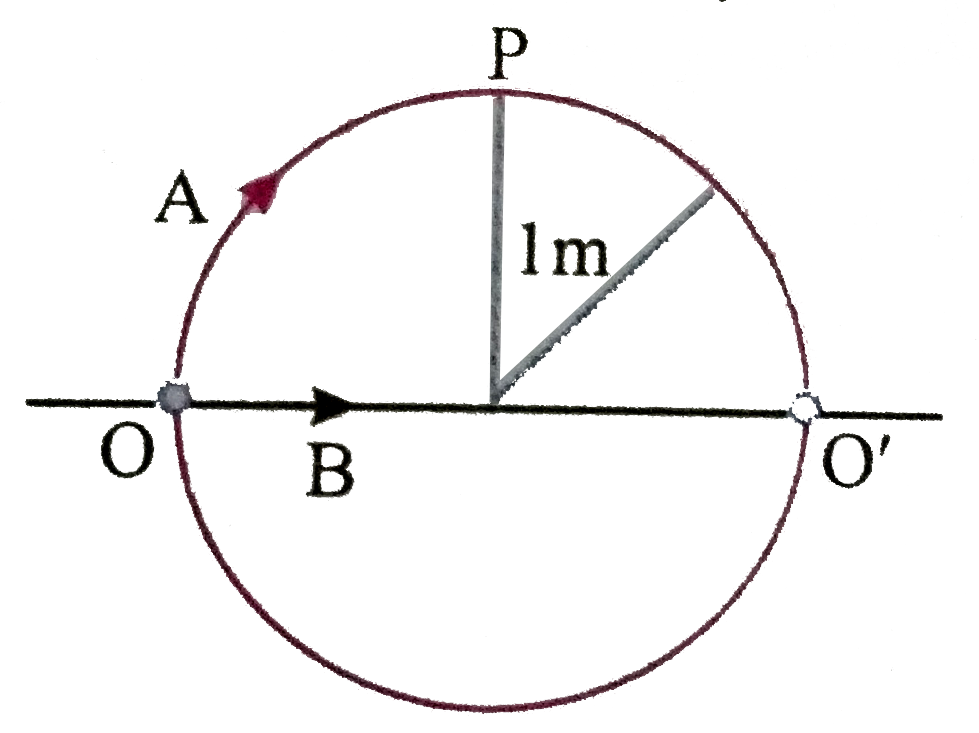A point moves along a circle with a velocity v=t/2. Find the acceleration of the point at the moment when it has covered a quarter circle from the beginning of motion.
v=t2
at=dvdt=12 (constant)
Time taken by the particle to complete a half-circle
s=ut+12att2
πR2=0+12×12t2⇒t2=2πR
ac=v2R=(t/2)2R=t24R=2πR4R=π2
the resultant acceleration when the particle has covered a quarter circle
a=√a2c+a2t=√(π2)2+(12)2=12√π2+1
Related Playlists
Knowledge Check
- Question 1 - Select One
A point moves along a circle with velocity v = at where a 0.5 m/sec2. Then the total acceleration of the point at the moment when it covered (1/10) th of the circle after beginning of motion -
A0.5m/sec2B0.6m/sec2C0.7m/sec2D0.8m/sec2 - Question 1 - Select One
A point moves along a circle with speed v=at. The total acceleration of the point at a time when it has traced 1//8th of the circumference is:
Av8aB2a√4+π2CaDa2√4+π2 - Question 1 - Select One
A small ball thrown at an initial velocity v0 at an angle α to the horizontal strikes elastically with a smooth vertical wall moving towards it at a horizontal velocity v and returns to the point from which it was thrown. Determine the time t from the beginning of motions to the moment of impact with vertical wall. Neglect friction losses.
At=v0sinα(v0cosα+2v)g(v0cosα+v)Bt=v0sinα(v0cosα−2v)g(v0cosα+v)Ct=v0sinα(v0cosα+2v)g(v0cosα−v)Dt=v0cosα(v0sinα+2v)g(v0sinα+v) - Question 1 - Select One or More
A particle 'A' moves along a circle with a velocity v=at, where a=0.50m/s2. Another particle B moves along a diameter OO' of the circle with the velocity v=at. Both the particles start simultaneously at t=0 from the point O on the circle. For these particles, (the radius of circle=1m).
 AThe velocity of B relative to A at the instant when A is at the point O' is zero.BThe velocity of B relative to A when A is at P for the first time is zero.CThe velocity vector of A with respect to B has zero component along the vector direction OO' at all times.DThe distances moved by A and B in their respective paths are the same at all times.
AThe velocity of B relative to A at the instant when A is at the point O' is zero.BThe velocity of B relative to A when A is at P for the first time is zero.CThe velocity vector of A with respect to B has zero component along the vector direction OO' at all times.DThe distances moved by A and B in their respective paths are the same at all times. - Question 1 - Select One
A particle moves along a cirvle of radius 'R' with speed varies as v=a0t, where a0 is a positive constant. Then the angle between the velocity vector and the acceleration vertor of the particle when it has covered one fourth of the circle is
Atan−1(π4)Btan−1(π2)Ctan−1(π)Dtan−1(2π) - Question 1 - Select One
A point mass moves along a circle of radius R with a constant angular acceleration α. How much time is needed after motion begins for the radial acceleration of the point mass to be equal to its tangential acceleration ?
A√1αB√RαC√2αD√12α
Similar Questions
A point moves along a circle with a speed v=kt , where K=0.5m/s2
Find the total acceleration of the point the momenet when it has covered the nth Fraction of the circle after the beginging of motion, where n=110 .View SolutionA particle is moving on a circular path with speed given by v= αt, where α is a constant. Find the acceleration of the particle at th instant when it has covered the nth fraction of the . Circle.
View SolutionA point mass starts moving in a straight line with a constant acceleration a. At a time t1 a fter the beginning of motion, the acceleration changes sign, remaining the same in magnitude. Determine the time t from the beginning of motion in which the point mass returns to the initial position.
View SolutionA particle of mass m moves along a circle of radius R. Find the modulus of the average vector of the force acting on the particle over the distance equal to a quarter of the circle, if the particle moves
(a) uniformly with velocity v,
(b) with constant tangential acceleration wτ, the initial velocity being equal to zero.View Solution

